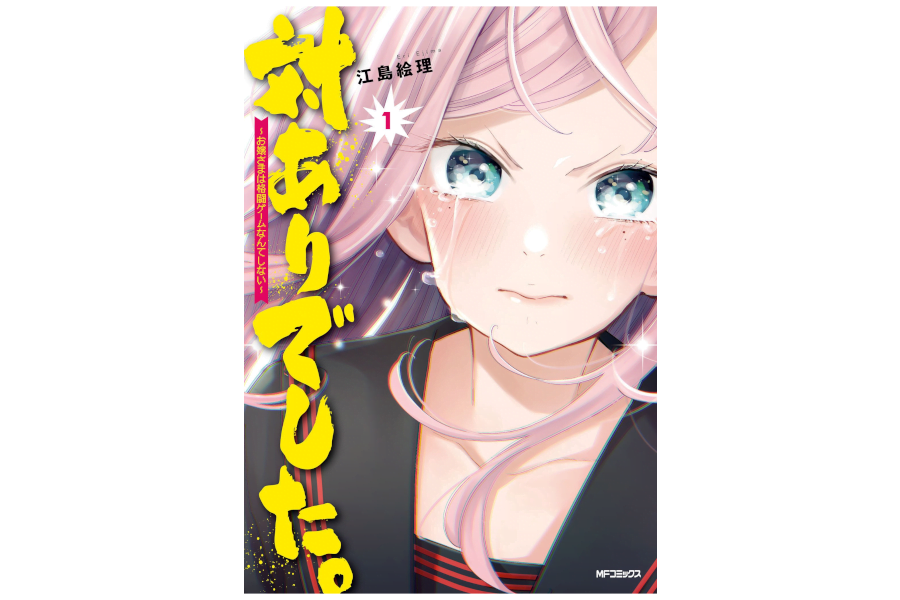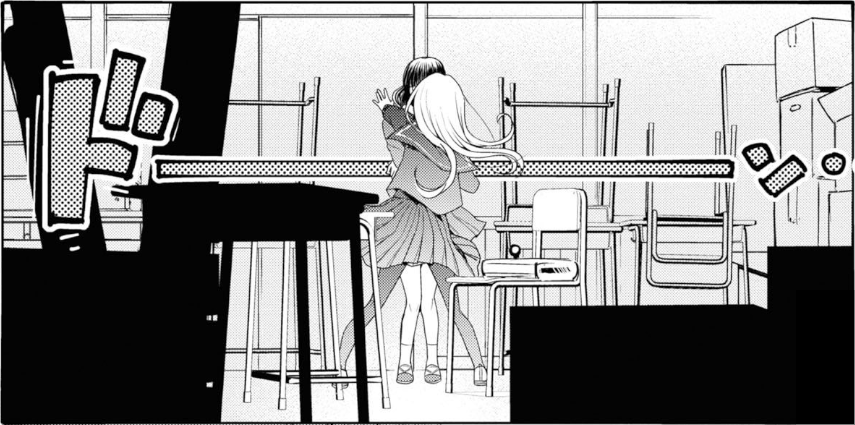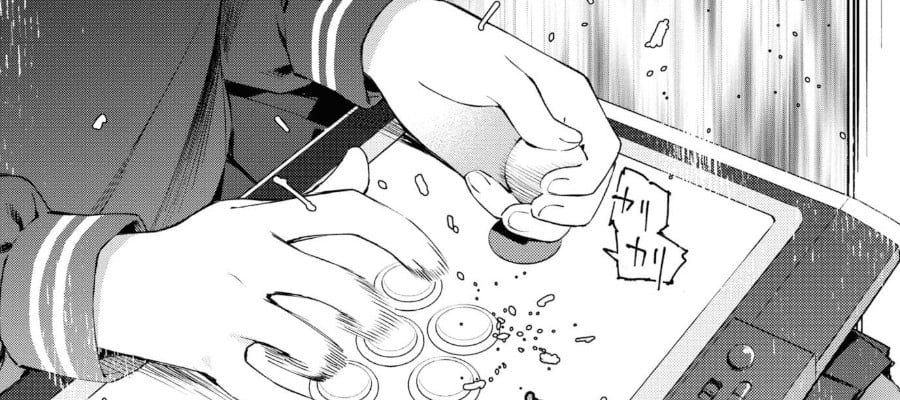What if the prettiest girl in your school who nobody knew well was so aloof, so pure, so perfect, not because she was in fact, transcendentally perfect, but because she was an utter gamer gremlin who didn’t care about anything any other student was doing, since they weren’t pulling off sick combos and trash talking noobs in ranked ladder matches? And you could tell because you were an expert in the same kind of games, and now she wanted to fight you? To fight you? To fight you? To stay up late and fight you?
And you were both girls?

That’s the story of Young Ladies Don’t Play Fighting Games, which is a manga series about exactly what I just described. This is a Japanese story about a Japanese sector of life – about the pressures of school and the intensity of hobbies you wind up with if you have to have them in secret. It’s about social pressures on women, it’s about what is or isn’t acceptable for people to do and how an invisible online persona creates a space for people to become what they truly want.
It is also full of some of the sickest reaction panels of a girl power-posing over an opponent who isn’t even in the room I’ve ever seen in manga.
If you want to learn a bit about fighting game lingo, this might be a place to pick it up, but I’m not sure. Part of how the story works is that the playstyles of the characters and their relationships to the games they’re playing is important to how they relate to one another, you see, you see, because the big crybaby who plays by her heart and wants to win because of how it makes her feel, right, she’s not as good a technical player as the much more skilled formally minded one who achieves by dedicating absolute organisation to everything she does, but but but when you’re a technically focused person what do you do when patch notes drop for your character a week before the tournament, and then, then, you see, there’s conflict between them because one of them is trying out new toys she got in the patch notes and the other is trying to reconstruct what she had.
I do not know if they say a damn word that makes sense about fighting games.
I know that there’s a procession through translation that’s going to make the best translators struggle. You need to understand the lingo in Japanese and its relationship to similar lingo in English and I can understand just giving up. It’s also all talking about a pastiche game that I think is meant to invoke Street Fighter, but also…
… it might not.
It could be nothing to do with Street Fighter. It could all be about Tekken or King of FIghters or Sango Fighters for all I know. I did show panels to a friend who knows a lot more about fighting games, and sometimes the manga gave good advice and sometimes it gave bad advice. But I can’t say for sure if that’s the manga being mistaken or if it’s the translation struggling with conveying a topic. Just a misplaced pronoun can really mess up that kind of thing! Doesn’t really matter, though, to me. It’s trying, and that’s interesting, and what it is telling me about the games is being used to tell the story at large. I could bust out the Gina Bloom Gaming the Stage checklist again, if you want.

There’s a real art to translation. Particularly, there are times when a manga has a really interesting title in Japanese that, translated to English, loses something about what it is. There’s this manga, Watashi no Kobushi wo Uketomete, which is about a pair of delinquent girls re-finding one another after school and realising they’re interested in one another, and the title means something about attacking one another with love and fists. Translating that title could have been something really awkward, but some genius translator came up with Catch These Hands.
I knew Young Ladies Don’t Play Fighting Games by a shorthand title: GGWP, back when it was being translated by fans, and not by professionals, selling the manga in actual book stores. It’s not only gotten an official translation since but it might be getting an anime soon, which is good news since it might make this series more available to more people. It might also dilute the queerness here, the way this story is about girls and their relationships to one another and the intimacy that grows in a slow, organic way and how the fights are about fights (but they’re not just about fights).
Here’s the big secret of if you’re looking for queer media. Queer anime isn’t common. It’s not uncommon, but it’s absolutely not common, and part of how queer anime gets to exist is by not being too far out of bounds of acceptable, deniable value judgments. Basicaly, anime gets to exist as long as the shittiest dude in its production staff is okay with it. Also, that kind of production staff role, the people who make hiring and firing decisions? Well, that’s a senior position and in Japan, seniority of roles aren’t necessarily tied to who in the room has the best ambitious drive or even the richest dad, but instead, tends to land on the oldest people.
That is to say, in the anime industry, where young people join and burn out in one to three years, all the people in positions of power are older. A lot older. Old as balls. And that may be why anime, despite all of its cool traits and its great imaginative concepts advertising all sorts of merchandiseable nonsense, still has a bunch of trends that feel like hey, why would we do that? Why would there be that in there? Isn’t that a bit weird?
Manga, on the other hand, is not so constrained. You know what you need to publish a manga? A pixiv account. Wotakoi, one of my favourite manga and anime ever, started out as a pixiv webcomic. Horimiya, a series with a really promising start that I kinda snoozed through towards the end, started out as a webcomic. The Guy She Was Interested In Wasn’t A Guy At All, one of my favourite yuri series started out on twitter. The point is there are a lot of publishing vectors for manga, and that doesn’t mean everyone who wants to make and share manga are doing it in a way that’s going to get them money but they can get attention and as a result, manga is a space where you’re going to see a lot more wild stuff.

And yes, this does mean you’ll find more filth and weirdness and stuff people ditch on because they get bored. Sure. That’s a possibility. You’re talking about an art space where amateur art gradiates into professional art without any clear distinction and the industry that pumps out the series on schedules people like are essentially a machine that chews on artists and poops out merchandising opportunities, with the manga itself a sort of wafting fumes it expels as an accidental byproduct. Sometimes you’ll find an interesting high concept that disappears because the artist just couldn’t hack the pace they set and they dropped out, sometimes you’ll find something that degenerates over time as the creator’s hobby time changes.
And in this space, you can find queer media.
You can find, straight up, media that is just about gay boys doin’ kisses on one another and yuri that’s all about a particular niche interest and just, no question being asked about a potential market importance, because it’s being made because someone wanted to draw those faces having feelings about those things. And that’s how we get the space in which we wind up here with this, this manga GGWP, a sexless yuri manga about girls who play fighting games in secret and also sleep together and are girlfriends.
It’s a long hauler! It goes places and it covers tournaments and I don’t know if it’s even done because I’ve been reading it entirely legally, officer, I swear. But it’s a very sweet kind of story about girls relating to girls, and if it doesn’t wind up with two of them married, then I’m going to notify the yuri authorities.